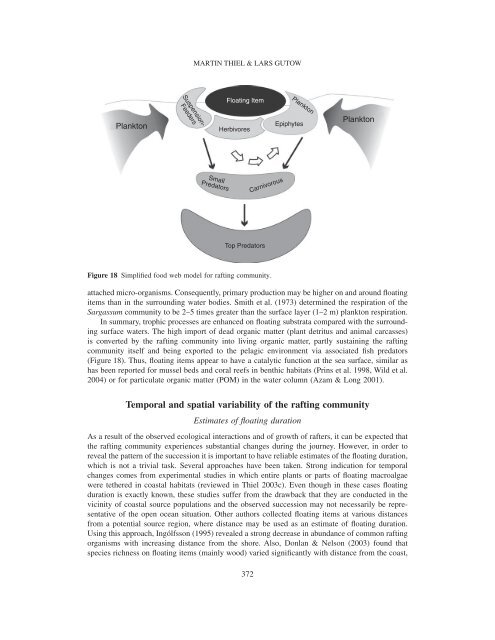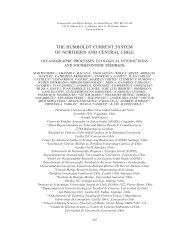The ecology of rafting in the marine environment - Bedim
The ecology of rafting in the marine environment - Bedim
The ecology of rafting in the marine environment - Bedim
You also want an ePaper? Increase the reach of your titles
YUMPU automatically turns print PDFs into web optimized ePapers that Google loves.
Plankton<br />
Suspension-<br />
Feeders<br />
MARTIN THIEL & LARS GUTOW<br />
Small<br />
Predators<br />
Float<strong>in</strong>g Item<br />
Herbivores<br />
Top Predators<br />
Figure 18 Simplified food web model for <strong>raft<strong>in</strong>g</strong> community.<br />
attached micro-organisms. Consequently, primary production may be higher on and around float<strong>in</strong>g<br />
items than <strong>in</strong> <strong>the</strong> surround<strong>in</strong>g water bodies. Smith et al. (1973) determ<strong>in</strong>ed <strong>the</strong> respiration <strong>of</strong> <strong>the</strong><br />
Sargassum community to be 2–5 times greater than <strong>the</strong> surface layer (1–2 m) plankton respiration.<br />
In summary, trophic processes are enhanced on float<strong>in</strong>g substrata compared with <strong>the</strong> surround<strong>in</strong>g<br />
surface waters. <strong>The</strong> high import <strong>of</strong> dead organic matter (plant detritus and animal carcasses)<br />
is converted by <strong>the</strong> <strong>raft<strong>in</strong>g</strong> community <strong>in</strong>to liv<strong>in</strong>g organic matter, partly susta<strong>in</strong><strong>in</strong>g <strong>the</strong> <strong>raft<strong>in</strong>g</strong><br />
community itself and be<strong>in</strong>g exported to <strong>the</strong> pelagic <strong>environment</strong> via associated fish predators<br />
(Figure 18). Thus, float<strong>in</strong>g items appear to have a catalytic function at <strong>the</strong> sea surface, similar as<br />
has been reported for mussel beds and coral reefs <strong>in</strong> benthic habitats (Pr<strong>in</strong>s et al. 1998, Wild et al.<br />
2004) or for particulate organic matter (POM) <strong>in</strong> <strong>the</strong> water column (Azam & Long 2001).<br />
Temporal and spatial variability <strong>of</strong> <strong>the</strong> <strong>raft<strong>in</strong>g</strong> community<br />
Estimates <strong>of</strong> float<strong>in</strong>g duration<br />
As a result <strong>of</strong> <strong>the</strong> observed ecological <strong>in</strong>teractions and <strong>of</strong> growth <strong>of</strong> rafters, it can be expected that<br />
<strong>the</strong> <strong>raft<strong>in</strong>g</strong> community experiences substantial changes dur<strong>in</strong>g <strong>the</strong> journey. However, <strong>in</strong> order to<br />
reveal <strong>the</strong> pattern <strong>of</strong> <strong>the</strong> succession it is important to have reliable estimates <strong>of</strong> <strong>the</strong> float<strong>in</strong>g duration,<br />
which is not a trivial task. Several approaches have been taken. Strong <strong>in</strong>dication for temporal<br />
changes comes from experimental studies <strong>in</strong> which entire plants or parts <strong>of</strong> float<strong>in</strong>g macroalgae<br />
were te<strong>the</strong>red <strong>in</strong> coastal habitats (reviewed <strong>in</strong> Thiel 2003c). Even though <strong>in</strong> <strong>the</strong>se cases float<strong>in</strong>g<br />
duration is exactly known, <strong>the</strong>se studies suffer from <strong>the</strong> drawback that <strong>the</strong>y are conducted <strong>in</strong> <strong>the</strong><br />
vic<strong>in</strong>ity <strong>of</strong> coastal source populations and <strong>the</strong> observed succession may not necessarily be representative<br />
<strong>of</strong> <strong>the</strong> open ocean situation. O<strong>the</strong>r authors collected float<strong>in</strong>g items at various distances<br />
from a potential source region, where distance may be used as an estimate <strong>of</strong> float<strong>in</strong>g duration.<br />
Us<strong>in</strong>g this approach, Ingólfsson (1995) revealed a strong decrease <strong>in</strong> abundance <strong>of</strong> common <strong>raft<strong>in</strong>g</strong><br />
organisms with <strong>in</strong>creas<strong>in</strong>g distance from <strong>the</strong> shore. Also, Donlan & Nelson (2003) found that<br />
species richness on float<strong>in</strong>g items (ma<strong>in</strong>ly wood) varied significantly with distance from <strong>the</strong> coast,<br />
372<br />
Carnivorous<br />
Plankton<br />
Epiphytes<br />
Plankton










